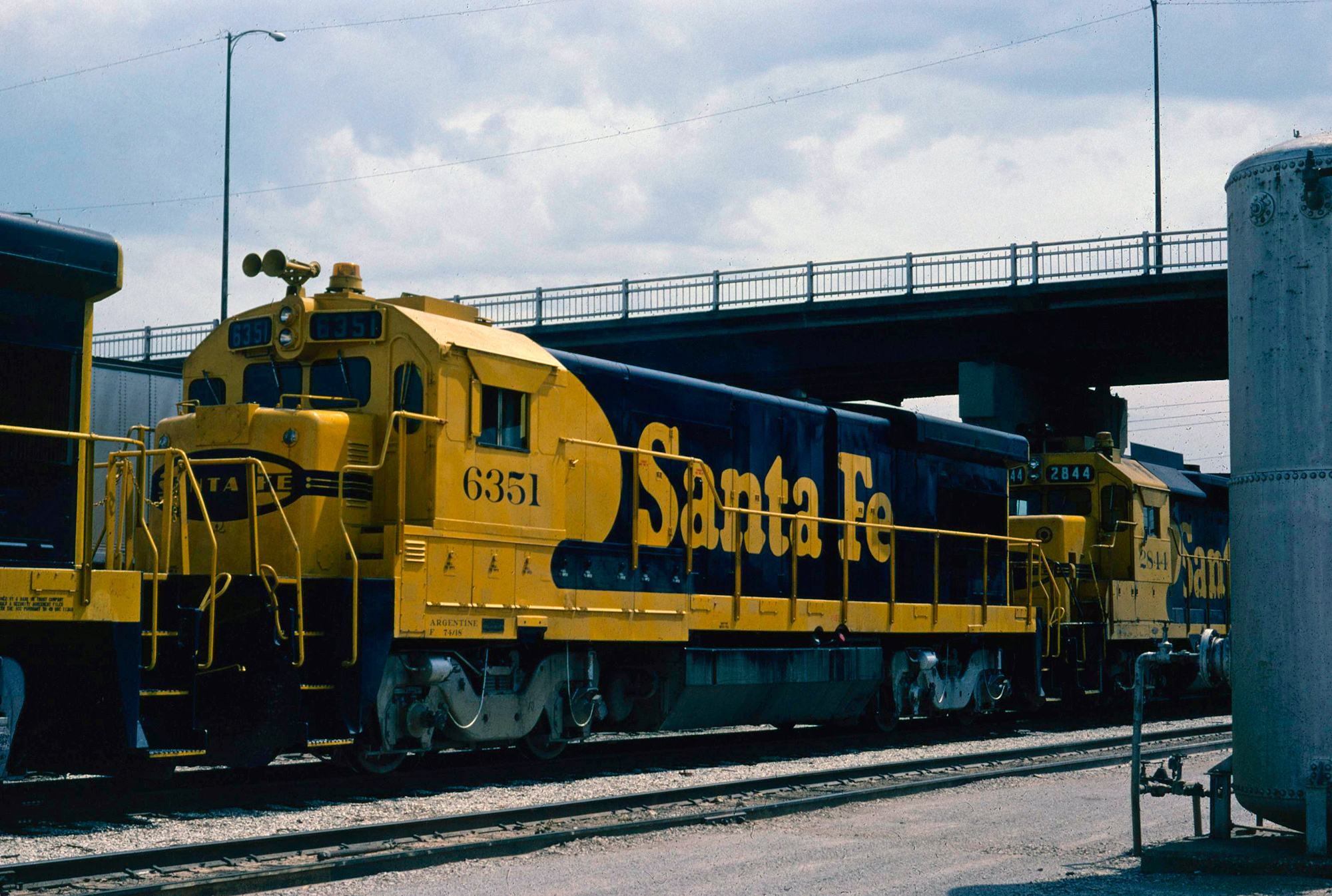GE "B23-7" and "BQ23-7" Locomotives: Specs, Roster, History
Last revised: January 1, 2025
By: Adam Burns
The B23-7 was General Electric's first four-axle model
of its new "Dash 7" line, which featured upgraded equipment and
electronics.
As Brian Solomon notes in his book, "GE Locomotives," the B23-7 followed the earlier Universal line, GE's initial entry into the locomotive market as an independent manufacturer.
This particular model followed the U23B, a successful medium-horsepower, late era U-boat that saw 481 units completed at Erie.
The B23-7 continued this success and sold 545 units by the time production had ended in December, 1984. While EMD's SD40-2 line was unmatched during the 1970s, the "Dash 7" line would eventually help unseat Electro-Motive as the industry's top builder.
Today, you can still find the locomotive in active revenue service on smaller lines around the country, many of which have been rebuilt and upgraded over the years. Today, there is currently one known B23-7 preserved; Conrail #1943 found at the Conway Scenic Railway.
Photos
 CSX BQ23-7 #3008 was photographed here by Wade Massie at Russell, Kentucky on August 8, 1991. Built for Seaboard Coast Line the "Q" designated "Quarters" and the model was identical to the B23-7 save for the larger cab. An experimental design, the SCL was attempting to save money by removing the caboose and placing the entire crew at the head end. The original 10 were the only units ever built.
CSX BQ23-7 #3008 was photographed here by Wade Massie at Russell, Kentucky on August 8, 1991. Built for Seaboard Coast Line the "Q" designated "Quarters" and the model was identical to the B23-7 save for the larger cab. An experimental design, the SCL was attempting to save money by removing the caboose and placing the entire crew at the head end. The original 10 were the only units ever built.History
The B23-7 was quite similar to its earlier cousin, the U23B. As Greg McDonnell notes in his book, "Locomotives: The Modern Diesel & Electric Reference, Second Edition," its notable external differences was:
- An increase in length by 2 feet.
- Larger Radiators.
- Removal of the two additional side windows which bracketed the main cab window. Brian Solomon notes in his book, "GE And EMD Locomotives," the introduction of more expensive Lexan shatterproof glass made railroads weary of spending the extra money on the extra panes.
- A slightly wider hood from just ahead of the exhaust stack to the radiator cab, which housed the relocated oil cooler. This "notch" is the easiest way to identify the "Dash 7" line over the earlier U-boat.
Other improvements not noticeable were largely internal and included:
- Better fuel efficiency (a 16% improvement during the "Dash 7" line's production run).
- Increased tractive effort.
- A more reliable locomotive.
- A better engine muffler to reduce noise, emissions, and improve fuel economy.
- Implementation of the standard AAR "Notch 8" throttle (also referred to as the "skip three, double seven"). GE had previously used a sixteen notch throttle on earlier U-boats, which intended to offer engineers better speed control.
The introduction of the "Dash 7" line brought with it new model designations and meanings behind the numbers and letters. In regards to the B23-7:
- "B" referred to a four-axle (B-B) locomotive.
- "23" designated the horsepower rating (in this case 2,250 horsepower was available at the traction motors).
- "7" indicated the "Dash 7" line was introduced in 1976.
The B23-7 used an updated version of GE's traction motor, the model 752AF; this enabled the road-switcher to boast 70,000 pounds of starting effort and 63,250 pounds of continuous effort at 10.7 mph.
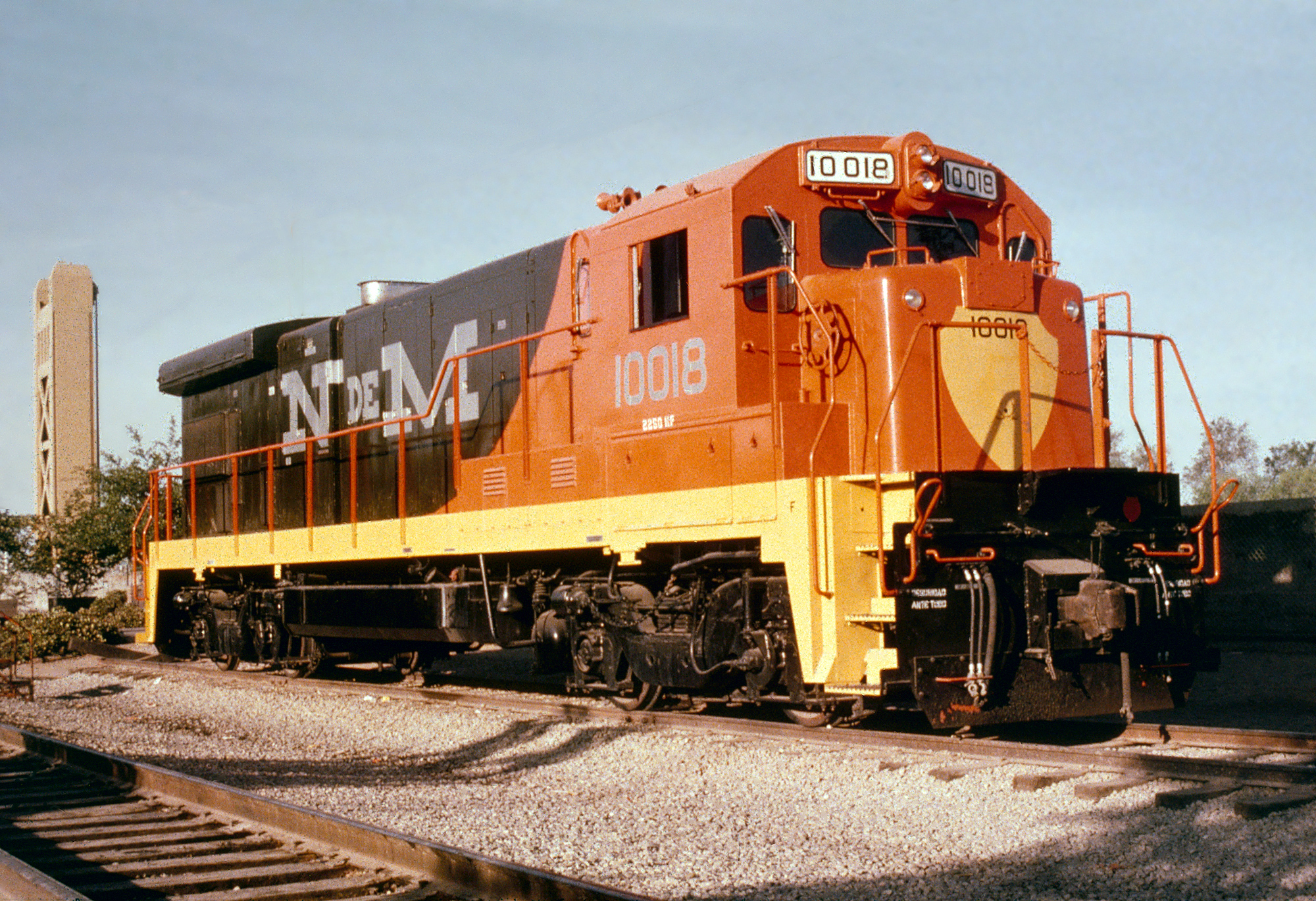 Ferrocarriles Nacionales de México (NdeM) B23-7 #10018 on display at Railfair '81 in Sacramento, California on May 5, 1981. American-Rails.com collection.
Ferrocarriles Nacionales de México (NdeM) B23-7 #10018 on display at Railfair '81 in Sacramento, California on May 5, 1981. American-Rails.com collection.For domestic lines there many buyers including Conrail (141), Missouri Pacific (85), Santa Fe (69), Louisville & Nashville (15), Providence & Worcester (1), Seaboard Coast Line (39, including 10 of the unique "BQ23-7" variant), Southern Pacific (15), Southern Railway (54), and Texas Utilities (2).
Additionally, Mexican lines Ferrocarriles Nacionales de México and Ferrocarriles Unidos del Sureste purchased 122 and 3 respectively.
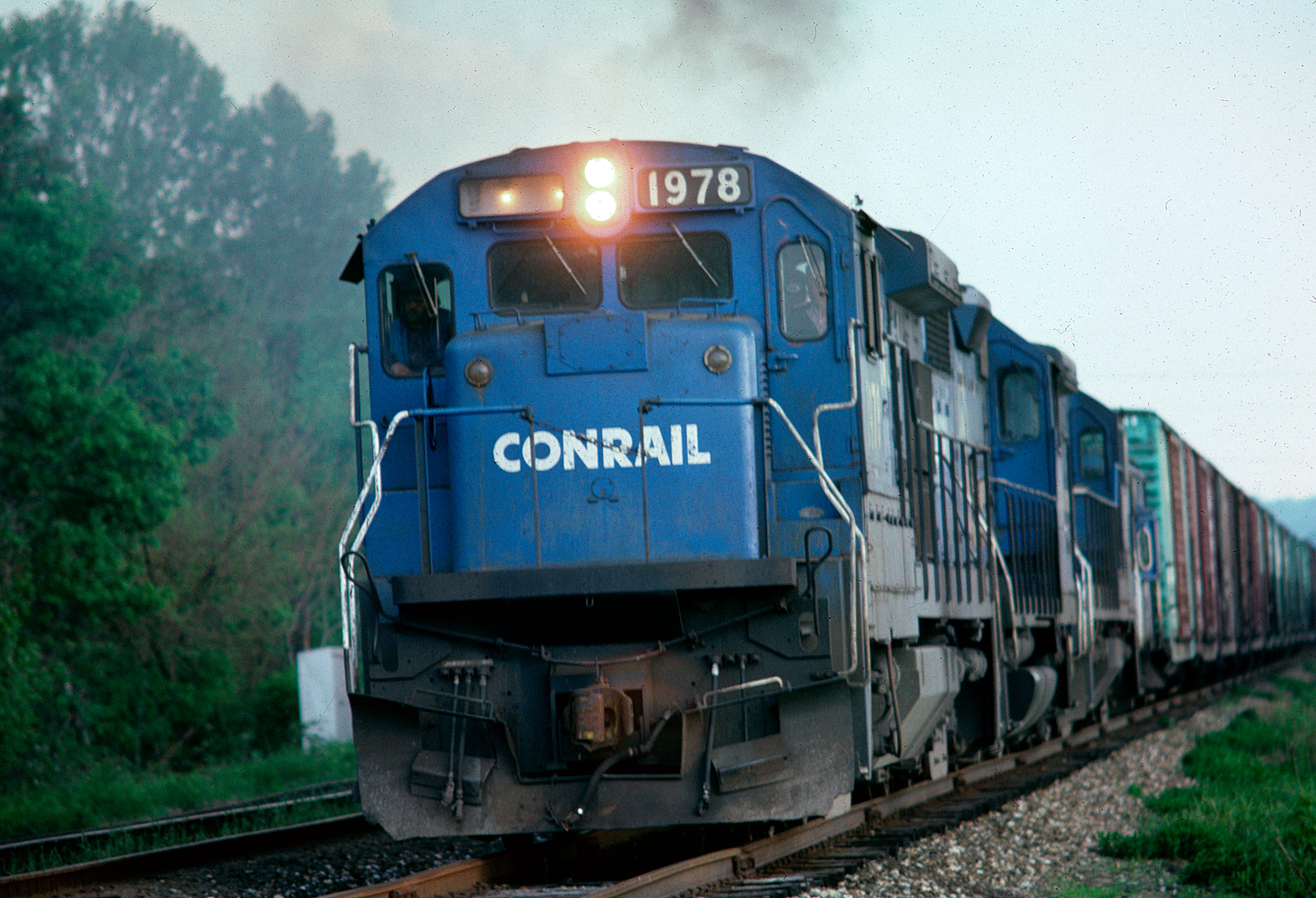 Conrail B23-7 #1978, missing a number board, leads a string of boxcars in Ohio during May of 1982. American-Rails.com collection.
Conrail B23-7 #1978, missing a number board, leads a string of boxcars in Ohio during May of 1982. American-Rails.com collection.BQ23-7
Of note is another 10 purchased by the Seaboard Coast Line known as the BQ23-7. The "Q" designated "Quarters" and the model was identical to the B23-7 save for the larger cab.
Basically an experimental design, the SCL was attempting to save money by removing the caboose from the end of the train and placing the entire crew in the lead locomotive.
The idea did not work quite as well as the railroad had hoped and no more were built. The BQ23-7s remained in service on CSX through the 1990s until they were finally retired.
Taking what it had learned through its Universal line, GE's "Dash 7" models proved much more reliable mechanically and electrically, even though the company still employed basic, boxy carbody designs.
Data Sheet
| Entered Production | 9/1977 (Conrail #2800) |
| Years Produced | 9/1977 - 12/1984 |
| GE Class | B23-7 |
| Engine | 7FDL12 (12 cylinder) |
| Engine Builder | General Electric |
| Horsepower | 2250 |
| RPM | 1050 |
| Length | 62' 2" |
| Height (Top Of Rail To Top Of Cab) | 15' 4" |
| Width | 9' 11" |
| Weight | 253,000 - 280,000 Lbs |
| Fuel Capacity | 2,150 Gallons |
| Air Compressor | 3CDC (Westinghouse) |
| Air Brake Schedule | 26NL (Westinghouse) |
| Trucks | B-B |
| Truck Type | Floating Bolster FB2 (GE) |
| Truck Wheelbase | 9' 4" |
| Wheel Size | 40" |
| Traction Motors | 752AF (4), GE |
| Traction Alternator | GTA11AC, GE |
| Auxiliary Generator | GY27, GE |
| MU (Multiple-Unit) | Yes |
| Dynamic Brakes | Yes |
| Gear Ratio | 83:20 |
| Tractive Effort/Starting | 70,000 Lbs |
| Tractive Effort/Continuous | 63,250 Lbs at 10.7 mph |
| Top Speed | 70 mph |
Production Roster
| Owner | Road Number | Serial Number | Order Number | Completion Date | Quantity |
|---|---|---|---|---|---|
| Conrail | 2800-2816 | 41609-41625 | 1410 | 9/1977-11/1977 | 17 |
| Santa Fe | 6350-6363 | 41673-41686 | 1449 | 4/1978-5/1978 | 14 |
| Louisville & Nashville | 5115-5129 | 41725-41739 | 1441 | 2/1978 | 15 |
| Providence & Worcester | 2201 | 41740 | 1454 | 3/1978 | 1 |
| Missouri Pacific | 2289-2298* | 41772-41781 | 1417 | 1/1978 | 10 |
| Seaboard Coast Line (Family Lines System) | 5100-5114 | 41797-41811 | 1447 | 1/1978-2/1978 | 15 |
| Conrail | 1900-1939 | 41907-41946 | 1451 | 5/1978-6/1978 | 40 |
| Seaboard Coast Line (Family Lines System) | 5130-5139 (BQ23-7)** | 41947-41956 | 1453 | 10/1978 - 1/1979 | 10 |
| Southern Railway | 3970-3979 | 41979-41988 | 1445 | 9/1978 | 10 |
| Southern Railway | 3980-3989 | 41989-41998 | 1491 | 1/1979 | 10 |
| Conrail | 1940-1966 | 42053-42079 | 1456 | 7/1978-9/1978 | 27 |
| Seaboard Coast Line (Family Lines System) | 5140-5153 | 42123-42136 | 1492 | 9/1978 | 14 |
| Missouri Pacific | 2299-2318* | 42148-42167 | 1452 | 10/1978-11/1978 | 20 |
| Conrail | 1967-1991 | 42305-42329 | 1493 | 3/1979-4/1979 | 25 |
| Santa Fe | 6364-6389 | 42410-42435 | 1496 | 4/1979-6/1979 | 26 |
| Texas Utilities | 3306 | 42436 | 1406 | 8/1979 | 1 |
| Conrail | 1992-2023 | 42539-42570 | 1409 | 7/1979-9/1979 | 32 |
| Ferrocarriles Unidos del Sureste | 522-524 | 42623-42625 | 1408 | 12/1979 | 3 |
| Ferrocarriles Nacionales de México | 9130-9139 | 42626-42635 | 1407 | 12/1979-1/1980 | 10 |
| Missouri Pacific | 2319-2338* | 42680-42699 | 1403-2 | 11/1979-12/1979 | 20 |
| Santa Fe | 6390-6404 | 42929-42943 | 1414 | 4/1980 | 15 |
| Missouri Pacific | 4650-4659 | 42944-42953 | 1416-2 | 4/1980 | 10 |
| Southern Pacific | 5100-5114 | 42979-42993 | 1421 | 6/1980 | 15 |
| Missouri Pacific | 4660-4669*** | 43021-43030 | 1422 | 6/1980 | 10 |
| Southern Railway | 3990-4009 | 43110-43129 | 1423 | 2/1981-3/1981 | 20 |
| Texas Utilities | 3307 | 43192 | 1413 | 10/1981 | 1 |
| Ferrocarriles Nacionales de México | 9140-9145 | 43250-43255 | 1472 | 8/1980-9/1980 | 6 |
| Ferrocarriles Nacionales de México | 9178-9180 | 43291-43293 | 1414 | 6/1981 | 3 |
| Ferrocarriles Nacionales de México | 12001-12006 | 43294-43299 | 1402 | 2/1982-3/1982 | 6 |
| Ferrocarriles Nacionales de México | 9146-9177 | 43328-43359 | 1478 | 11/1980-1/1981 | 32 |
| Ferrocarriles Nacionales de México | 1-01 thru 1-08 | 43360-43367 | 1479 | 1/1981-2/1981 | 8 |
| Southern Railway | 4010-4023 | 43368-43381 | 1492 | 3/1981-4/1981 | 14 |
| Ferrocarriles Nacionales de México | 10001-10013 | 43382-43394 | 1426 | 10/1980-2/1981 | 13 |
| Ferrocarriles Nacionales de México | 12007-12011 | 43395-43399 | 1402 | 4/1982-5/1982 | 5 |
| Ferrocarriles Nacionales de México | 10014-10032 | 43500-43518 | 1471 | 2/1981-6/1981 | 19 |
| Ferrocarriles Nacionales de México | 10033-10046 | 43519-43532 | 1474 | 11/1981-12/1981 | 14 |
| Missouri Pacific | 4670-4684 | 43533-43547 | 1473 | 4/1981-5/1981 | 15 |
| Ferrocarriles Nacionales de México | 10047-10052 | 43580-43585 | 1474 | 12/1981-1/1982 | 6 |
| Santa Fe | 6405-6418 | 44081-44094 | 1491 | 12/1984 | 14 |
* Later renumbered 4000-4049.
** The BQ23-7 was equipped with an extra large head-end cab to accommodate all five crewman. It was attempt to eliminate the caboose.
*** Missouri Pacific #4667-4669 was completed as the upgraded, 3,000 horsepower B30-7A. The units were externally identical to the B23-7.
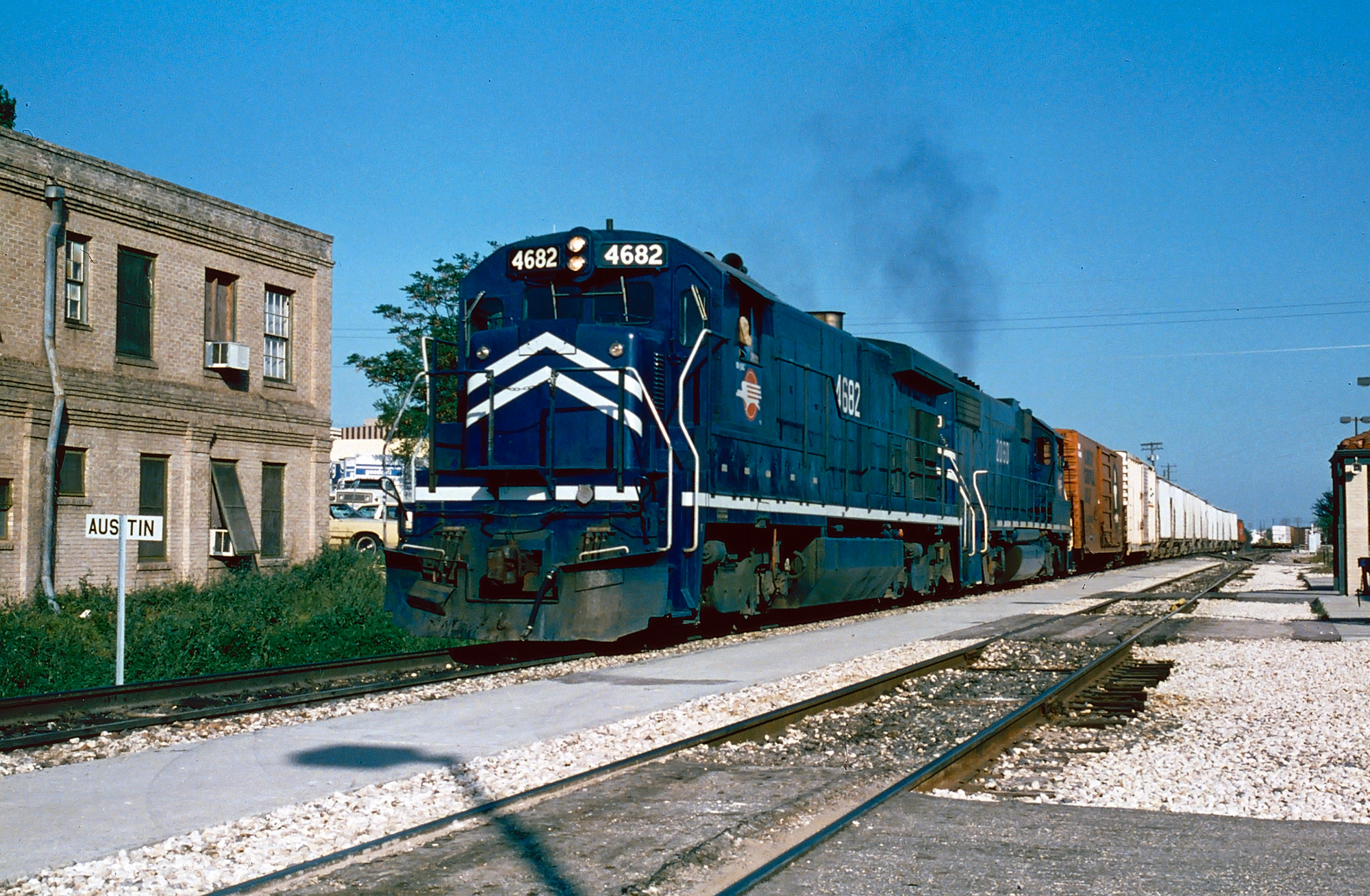 Missouri Pacific B23-7 #4682 and GP38-2 #2060 at Austin, Texas; December 17, 1983. Mike Bledsoe photo. American-Rails.com collection.
Missouri Pacific B23-7 #4682 and GP38-2 #2060 at Austin, Texas; December 17, 1983. Mike Bledsoe photo. American-Rails.com collection.FB2 Truck
For the first time ever, GE cataloged its floating bolster (FB2) truck as standard on the B23-7. However, some roads still opted for something different; Conrail used the old AAR Type-B's (General Steel Casting's swing bolster, drop-side equalizer) on their entire fleet and Santa Fe went with AAR's on 34 of its 69 B23-7's.
In addition, Southern Railway, whose B23-7's sported high short hoods as was common practice on the railroad, rode on GE's standard FB2.
Finally, Seaboard Coast Line had theirs equipped with EMD's Blomberg trucks for a much smoother ride. Interestingly, SCL used trade-in Blomberg's on all of its earlier U-boats as well.
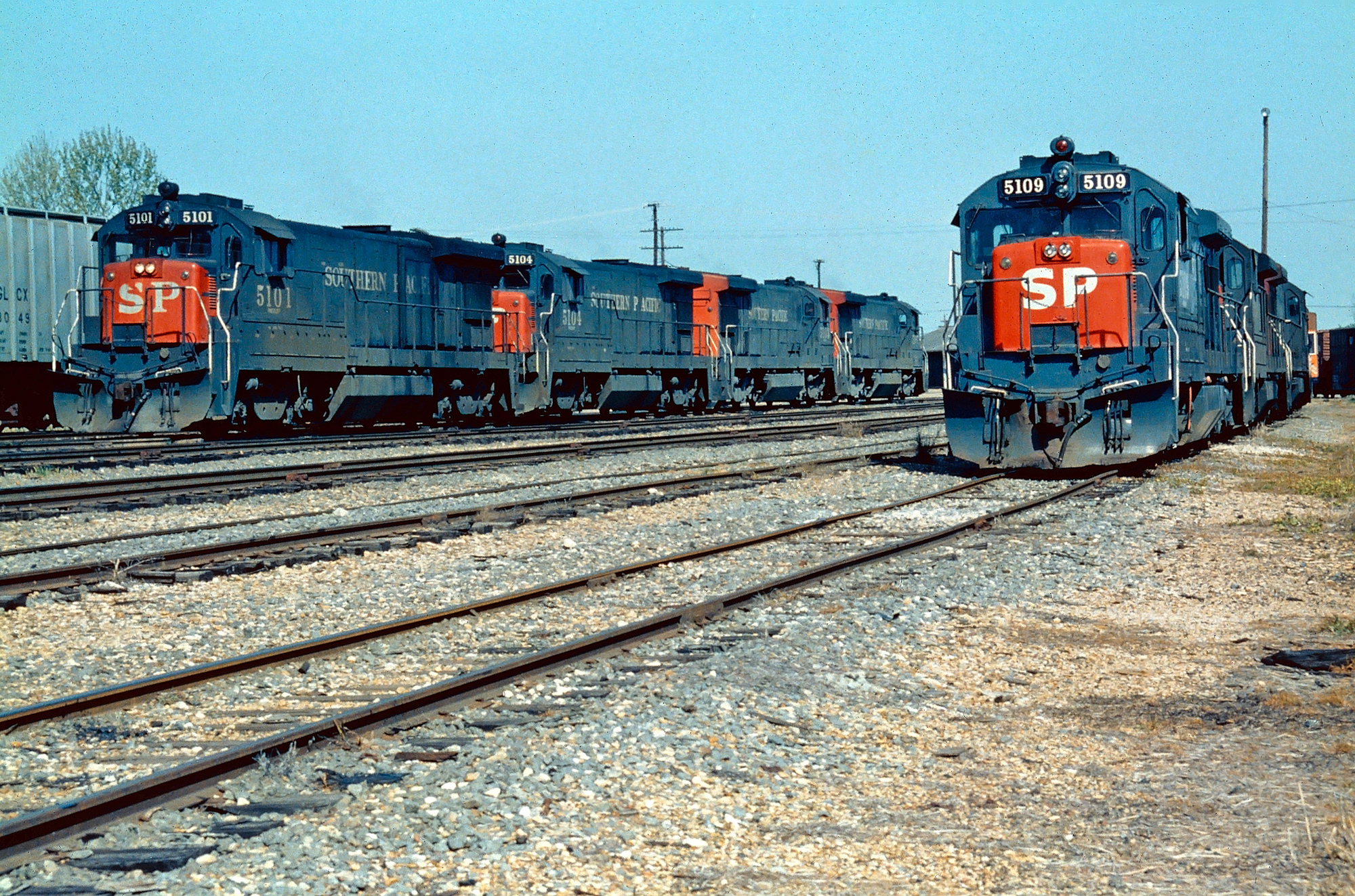 Nearly half of Southern Pacific's fleet of B23-7's can be seen here at Commerce, Texas in the spring of 1983. The SP purchased a small group of 15 units (5100-5114) in 1980. Mike Bledsoe photo. American-Rails.com collection.
Nearly half of Southern Pacific's fleet of B23-7's can be seen here at Commerce, Texas in the spring of 1983. The SP purchased a small group of 15 units (5100-5114) in 1980. Mike Bledsoe photo. American-Rails.com collection.Sources
- Foster, Gerald. A Field Guide To Trains. New York: Houghton Mifflin, 1996.
- Marre, Louis A. and Pinkepank, Jerry A. Contemporary Diesel Spotter's Guide, The: A Comprehensive Reference Manual To Locomotives Since 1972. Milwaukee: Kalmbach Publishing Company, 1989.
- McDonnell, Greg. Locomotives: The Modern Diesel & Electric Reference, 2nd Edition. Buffalo: Boston Mills Press/Firefly Books, 2015.
- Solomon, Brian. American Diesel Locomotive, The. Osceola: MBI Publishing, 2000.
- Solomon, Brian. GE and EMD Locomotives: The Illustrated History. Minneapolis: Voyageur Press, 2014.
- Solomon, Brian. GE Locomotives: 110 Years Of General Electric Motive Power. St. Paul: MBI Publishing, 2003.
Recent Articles
-
Pennsylvania - Whiskey - Train Rides
Dec 20, 25 09:06 PM
For whiskey aficionados and history buffs alike, a train ride through the Keystone State offering such spirits provides a unique and memorable experience. -
New Jersey Thomas The Train Rides
Dec 20, 25 06:32 PM
Here's a comprehensive guide to what you can expect at Day Out With Thomas events in New Jersey. -
Michigan Thomas The Train Rides
Dec 20, 25 06:28 PM
Here’s an in-depth look at what a typical "Day Out with Thomas" event in Michigan entails, what makes it special, and why it remains a must-visit for families.

